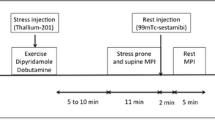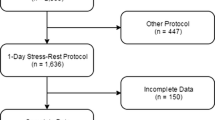Abstract
Technetium-99 m methoxy-isobutyl-isonitrile (SESTAMIBI) has been recently introduced to trace regional myocardial perfusion. Beyond blood flow distribution, a quantitative index of regional myocardial wall motion from SESTAMIBI electrocardiogram (ECG)-gated images was obtained, according to the assumption that changes in the detected radioactivity reflect changes in myocardial wall thickness during the cardiac cycle. As a preliminary study, 20 patients with coronary artery disease and regional wall motion abnormalities and 15 normal subjects were studied by SESTAMIBI scintigraphy and contrast ventriculography. Regional wall motion was analyzed by a radial method applied to both techniques. Absolute systolic changes in radioactivity and its ratio to reference normal values (wall thickening index, WTI) were determined in 9 anatomical cardiac regions according to the formula (endsystolic counting profile — enddiastolic counting profile/enddiastolic counting profile) × 100. The overall agreement between radioisotopic and ventriculographic techniques was 88% (158 of 180 segments). Normal, hypokinetic and akinetic ventriculographic segments showed WTI values of 1.1±0.2, 0.8±0.2 and 0.4 ±0.3 respectively (P< 0.001). A second clinical study was performed in 25 patients studied by stress/rest ECG-gated SESTAMIBI scintigraphy. The assumption of this part of the study was to investigate if a preserved wall thickening in segments with stress defects might predict those areas with normal resting perfusion. Partial or total normalization of regional perfusion was observed in 90% of segments with a WTI⩾0.8. These studies indicate the ECG-gated SESTAMIBI may represent a suitable technique for the simultaneous analysis of flow distribution and function. Analysis of post-exercise ECG-gated SESTAMIBI can predict the reversibility of transient perfusion defects.
Similar content being viewed by others
Abbreviations
- ECG:
-
electrocardiogram
- SESTAMIBI:
-
Technetium-99 m methoxy-isobutyl-isonitrile
- WTI:
-
wall thickening index
References
Gelberg HJ, Brundage BH, Glantz S, Parmley WW. Quantitative left ventricular wall motion analysis: a comparison of area, chord and radial methods. Circulation 1979; 59: 991–1000.
Mancini GB, Norris SL, Peterson KL, et al. Quantitative assessment of segmental mall motion abnormalities at rest and after atrial pacing using digital intravenous ventriculography. JACC 1983; 2: 70–6.
Haendchen RV, Wyatt HL, Maurer G, et al. Quantification of regional myocardial function by two-dimensional echocardiography. I. Patterns of contraction in the normal left ventricle. Circulation 1983; 67: 1234–45.
Zoghbi WA, Charlat ML, Bolli R, et al. End-systolic radius to thickness ratio: an echocardiographic index of regional performance during reversible myocardial ischemia in the conscious dog. JACC 1987; 10: 1113–21.
Lanzer P, Garrett J, Lipton MJ, et al. Quantification of regional myocardial function by cine computed tomography. Pharmacologic changes in wall thickness. JACC 1986; 8: 682–92.
Sechtem U, Sommerhof BA, Markiewicz W, White RD, Cheitlin MD, Higgins CB. Regional left ventricular wall thickening by magnetic resonance imaging: evaluation in normal persons and patients with global and regional dysfunction. Am J Cardiol 1987; 59: 145–51.
Leppo JA, O'Brien J, Rothlender JA, Getchell JD, Lee VW. Dipyridamole-thallium scintigraphy in the prediction of future cardiac events after acute myocardial infarction. N Engl J Med 1984; 310: 1014–18.
Iskandrian AS, Hakki A, Goel IP, Mundth ED, Kane Maarsh SA, Shenk CL. The use of exercise radionuclide ventriculography in risk stratification in patients with suspected coronary artery disease. Am Heart J 1985; 10: 864–71.
Hamilton GW, Narahara KA, Trobaugh GB, Ritchie JL, Williams GL. Thallium-201 myocardial imaging: characterization of the ECG-syncronized imaging. J Nucl Med 1978; 19: 1103–10.
Alderson PO, Wagner HL, Gomez-Moeiras JL, et al. Simultaneous detection of myocardial perfusion and wall motion abnormalities by cinematic 201-T1 imaging. Radiology 1978; 127: 531–3.
Sie ST, Holman BL. Dyanamic myocardial imaging in ischemic heart disease: use of Technetium 99m-isonitriles. Am J Cardiac Imaging 1987; 1: 125–31.
Kahn UK, Henderson EB, Akers MS, et al. Prediction of reversibility of perfusion defects with a single post-exercise technetium-99m RP-30A gated tomographic image: the role of residual systolic thickening. Circulation 1988; 78(4): 31A (abs).
Merz R, Maddahi J, Roy L, Berman DS. Gated RP-30 perfusion study after stress predicts myocardial viability (abstr). J Am Coll Cardiol 1987; 9: 27A.
Hoffman EJ, Huang SC, Phelps ME. Quantitation in positron emission computed tomography: I. Effect of object size. J Comput Assist Tomogr 1979; 5: 391–94.
Parodi O, Schelbert HR, Schwaiger M, Hansen H, Selin C, Hoffman EJ. Cardiac emission tomography: Underestimation of regional tracer concentrations due to wall motion abnormalities. J Comput Assist Tomogr 1984; 8: 1083–92.
Tomoike H, Ross Jr FD. Detection of myocardial ischemia by regional dysfunction during and after rapid pacing in the conscious dog. Circulation 1978; 1: 125–31.
Fujita M, Sasayama S, Kawai C, Eiho S, Kuwahara M. Automatic processing of cineventriculograms for analysis of regional myocardial function. Circulation 1981; 63:1065–74.
Austen WG, Edwards JE, Frye LR, et al. A reporting system on patients evaluated for coronary artery disease: report of the ad hoc committee for grading coronary artery disease. Council on cardiovascular surgery, American Heart Association. Circulation 1975; 51 (IV): 5–40.
Silverman KJ, Becker LC, Bulkley BH, et al. Value of early Thallium-201 scintigraphy for predicting mortality in patients with acute myocardial infarction. Circulation 1980; 61: 996–1003.
Patterson RE, Horowitz SF, Eng C, et al. Can noninvasive exercise test criteria identify patients with left main or 3-vessel coronary disease after a first myocardial infarction? Am J Cardiol 1983; 51: 361–372.
Van Train KF, Berman DS, Garcia EV, et al. Quantitative analysis of stress Thallium-201 myocardial scintigrams: a multicenter trial. J Nucl Med 1986; 27: 17–25.
Wackers FJ, Becker AE, Samson G, et al. Location and size of acute transmural myocardial infarction estimated from Thallium-201 scintiscans. Circulation 1977; 56: 72–9.
Gewirtz H, Grotte GJ, Strauss HW, et al. The influence of left ventricular volume and wall motion on myocardial images. Circulation 1979; 6: 1172–77.
Najim YC, Timmis AD, Maisey MN, et al. The evaluation of ventricular function using ECG-gated myocardial imaging with Tc-99m MIBI. Eur Heart J 1989; 10: 142–8.
Iskandrian AS, Heo J, Kong B, Lyons E, Marsch S. Use of technetium-99 m Isonitrile (RP-30A) in assessing left ventricular perfusion and function at rest and during exercise in coronary artery disease, and comparison with coronary arteriography and exercise Thallium-201 SPECT imaging. Am J Cardiol 1989; 64: 270–5.
Baillet GY, Mena IG, Kuperus JH, Robertson JM, French WJ. Simultaneous Technetium-99 m MIBI angiography and myocardial perfusion imaging. J Nucl Med 1989; 30: 38–44.
Kannell WB, Abbott RD. Incidence and prognosis of unrecognized myocardial infarction based on 26 years follow-up on the Framingham study. In: Rutishauer W, Roskamm H, editors, Silent myocardial ischemia, 131 Berlin: Springer-Verlag, 1984.
Braunwald E, Rutheford JD. Reversible ischemie left ven-tricular dysfunction: evidence for the ‘Hibernating Myocardium’. J Am Coll Cardiol 1986; 8: 1467–70.
Marcassa C, Galli M, Parodi O, Sambuceti G, Marzullo P, Bisi G, et al. Clinical significance of 99 m-Tc-MIBI uptake defects at rest in noninfarcted male patients [abstract]. J Am Coll Cardiol 1991; 17: 251A.
Author information
Authors and Affiliations
Rights and permissions
About this article
Cite this article
Marzullo, P., Marcassa, C., Sambuceti, G. et al. The clinical usefulness of electrocardiogram-gated Tc-99 m methoxy-isobutyl-isonitrile images in the detection of basal wall motion abnormalities and reversibility of stress induced perfusion defects. Int J Cardiac Imag 8, 131–141 (1992). https://doi.org/10.1007/BF01137534
Accepted:
Issue Date:
DOI: https://doi.org/10.1007/BF01137534




